Homemade Pancetta Recipe (Authentic Italian Style)
This homemade pancetta recipe is incredibly easy to make. Using the freshest, and best quality pork belly that you can find is the most important criteria, but most of the work is done by just waiting.
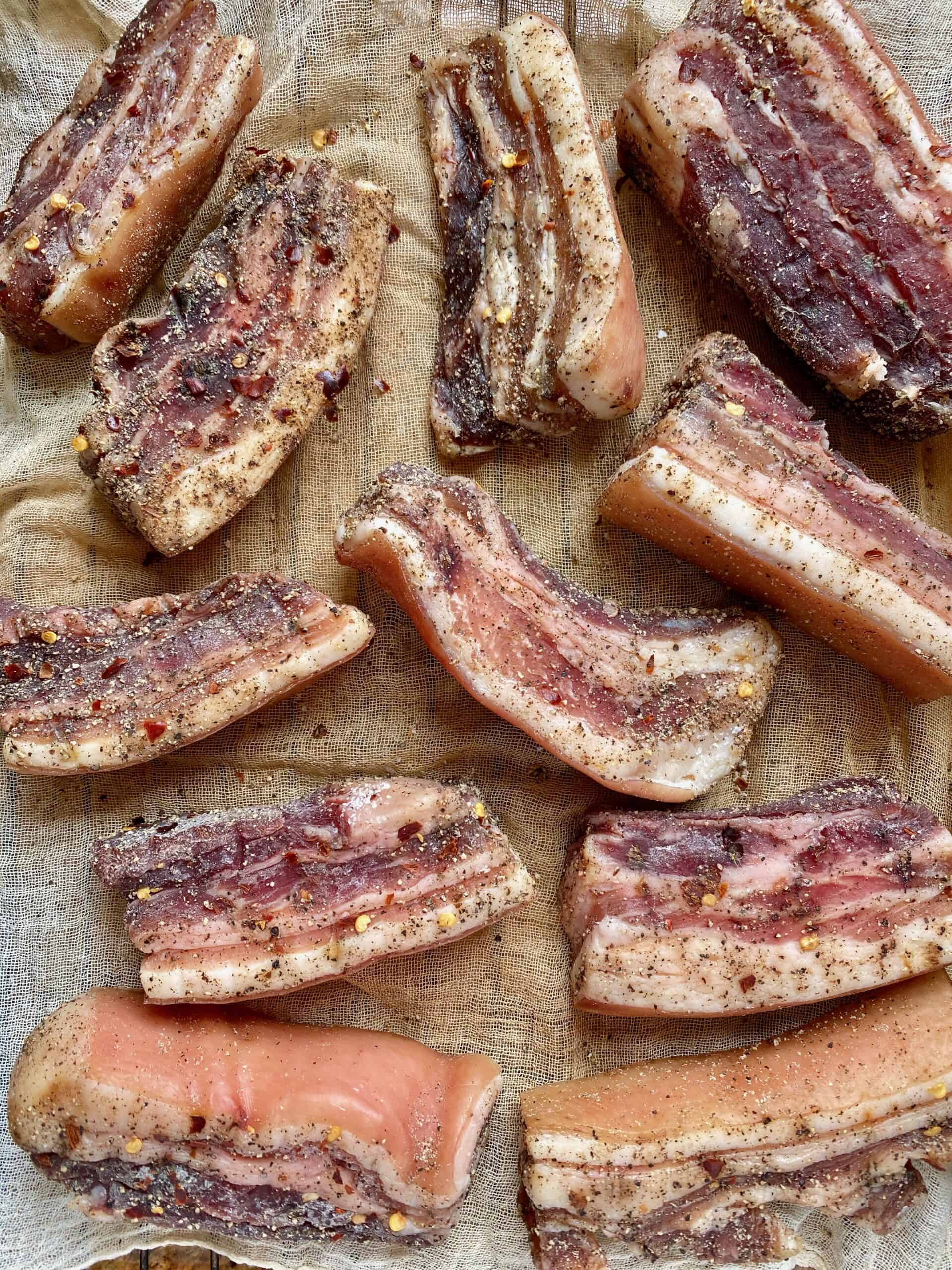
Did you ever think that you could easily make your own pancetta?
As an Amazon Associate I earn from qualifying purchases.
My nonni (grandparents) in Italy used to have homemade pancetta, sausages and prosciutto hanging in their cantina. Even as a child, these things were on par with “sweeties” and chocolate in my book! The smell of the cantina will forever be in my top five aromas, and quite possibly number one.


Since I’m now living in eternally warm and sunny Los Angeles, I cannot make these delicacies as my nonni did in their cantina. However, I’ve found that where there’s a will, there’s a way.
How, you ask? Well, everyone has a refrigerator, and that’s how. First of all, making your own pancetta will not only make you feel incredibly accomplished, but the quality and flavor will be so much better than what you can buy. This pancetta recipe also avoids using nitrates (pink curing salt) so that you end up with a healthier end product. Scroll down for more basic information about pancetta and how to use it.
Homemade Pancetta Recipe
(How to Make Pancetta)
recipe by my mother (Lidia Conte) FULL PRINTABLE RECIPE BELOW
Be sure to source good quality pork that has not been previously frozen and with preferably with the skin attached.
Day 1 -Salt the Pork Belly
Salt the pork pieces generously with Kosher Salt, put in a covered container, and leave for 24 hours in the fridge. The quantity of salt isn’t important as you’ll be rinsing it all off. Just make sure your pork belly looks the same as in the photo below. Do not use regular table salt, you need Kosher salt.
Day 2 -Rinse and Prepare the Pork Belly
The next day, (make sure it’s about 24 hours later, not 12 hours or 30 hours) rinse the pork with water, pat dry with a paper towel. Next, rinse in white wine, but this time do not pat dry.

Prepare a plate or tray with the desired amount of pepper in any combination (the amount shown does not make a very spicy pancetta). Mix all the pepper together. I love these stainless steel trays, they come in an interlocking set of three.
Rub the pepper into the pancetta pieces until well coated, adding more pepper as needed. Of course you can use different herbs to your liking, such as rosemary, and sage. However, just know that a pancetta recipe which adds spices like coriander and nutmeg is not an authentic Italian homemade pancetta recipe. If you plan to use your pancetta for Italian dishes, I recommend sticking to this recipe.
Set aside on waxed paper, or a clean wooden board, or plate.

You will need a small tray which will fit long wooden skewers to rest upon. This creates something that the pancetta pieces can be placed on to dry so that the air moves around it.

You can see what I have done here. NOTE: the skewers are underneath the pork pieces, they are not skewered through the pieces of meat.

The following 2 or 3 weeks – Curing the Pork Belly
This will be kept in the refrigerator, loosely covered with wax paper for about 2 to 3 weeks. Keep the pieces far enough apart to allow airflow; they should never be touching or close to each other. Turn the pieces everyday (turning on all 4 sides) until the pancetta has cured without becoming overly dry. You can weigh the pieces to check for moisture loss. At minimum, it should be 20% less than the amount you started with, and will look like this.
If your pancetta begins to smell foul or look discolored, do not eat it. This may happen for several reasons:
- the pork wasn’t fresh (or previously frozen)
- there isn’t enough airflow in the fridge; don’t try making pancetta if your fridge is packed and like a booby-trap!
- the pieces of pancetta are too close to each other, or touching
- the fridge temperature is off
Given you have done everything correctly, at this time, my preference is to seal it with a food sealer. This process seals out all the air, allowing the pancetta to keep refrigerated a longer period of time, while also stopping it from drying out any further.
Finally, you can use the homemade pancetta however you choose, but do not eat it without properly cooking it first.*
Pancetta Pasta with only 4 ingredients
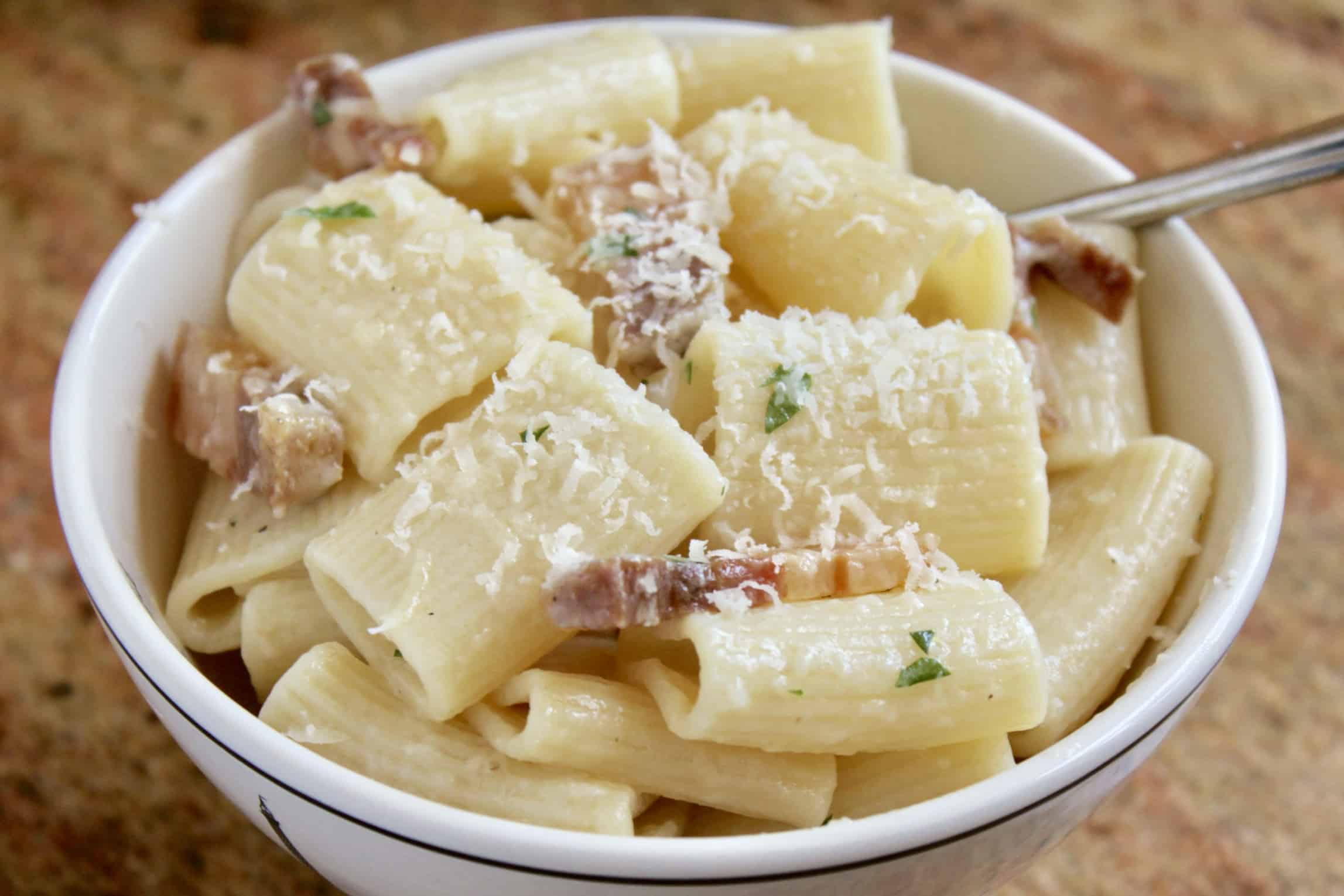
What is Pancetta?
Pancetta is simply dry cured Italian pork belly. This is the cut of meat you will need to buy in order to make pancetta. If you use another part of the pork, it will not be pancetta. It is salt-cured and often has black or red pepper added to the exterior, but contrary to Wikipedia, sugar is not commonly used in Italy.
I don’t want to get on my soap box again, but if you’re going to make something that is originally Italian, why would you use an American or British recipe which adds lots of unnecessary ingredients? There is absolutely no need for sugar or lots of herbs and spices when making pancetta.
How do I Use Homemade Pancetta?
Pancetta is used, and can be used in so many recipes. An easy way to think about how to use pancetta is to think about how you might use bacon in a recipe (usually pieces of bacon, because you can’t wrap pancetta around an olive or jalapeño pepper)!
While not authentic, using pancetta for Spaghetti alla Carbonara is the next best thing.

How do you Pronounce Pancetta?
C, followed by a vowel, is prounounced “ch” in Italian, so this means pancetta is pronounced, “pan-chey-tah”. Listen to hear the correct pronunciation of pancetta.
What’s a Substitute for Pancetta?
A good substitute for pancetta would be guanciale (made from pork cheek instead of pork belly), however, that is even more difficult to source in the US. As mentioned above, the next best substitute would be bacon. Try to find a thick cut, sugar and nitrate free bacon, for best results. It simply won’t be the same as using pancetta, though, so why find a substitute when you can make your very own?
Roasted Brussels sprouts with pancetta.
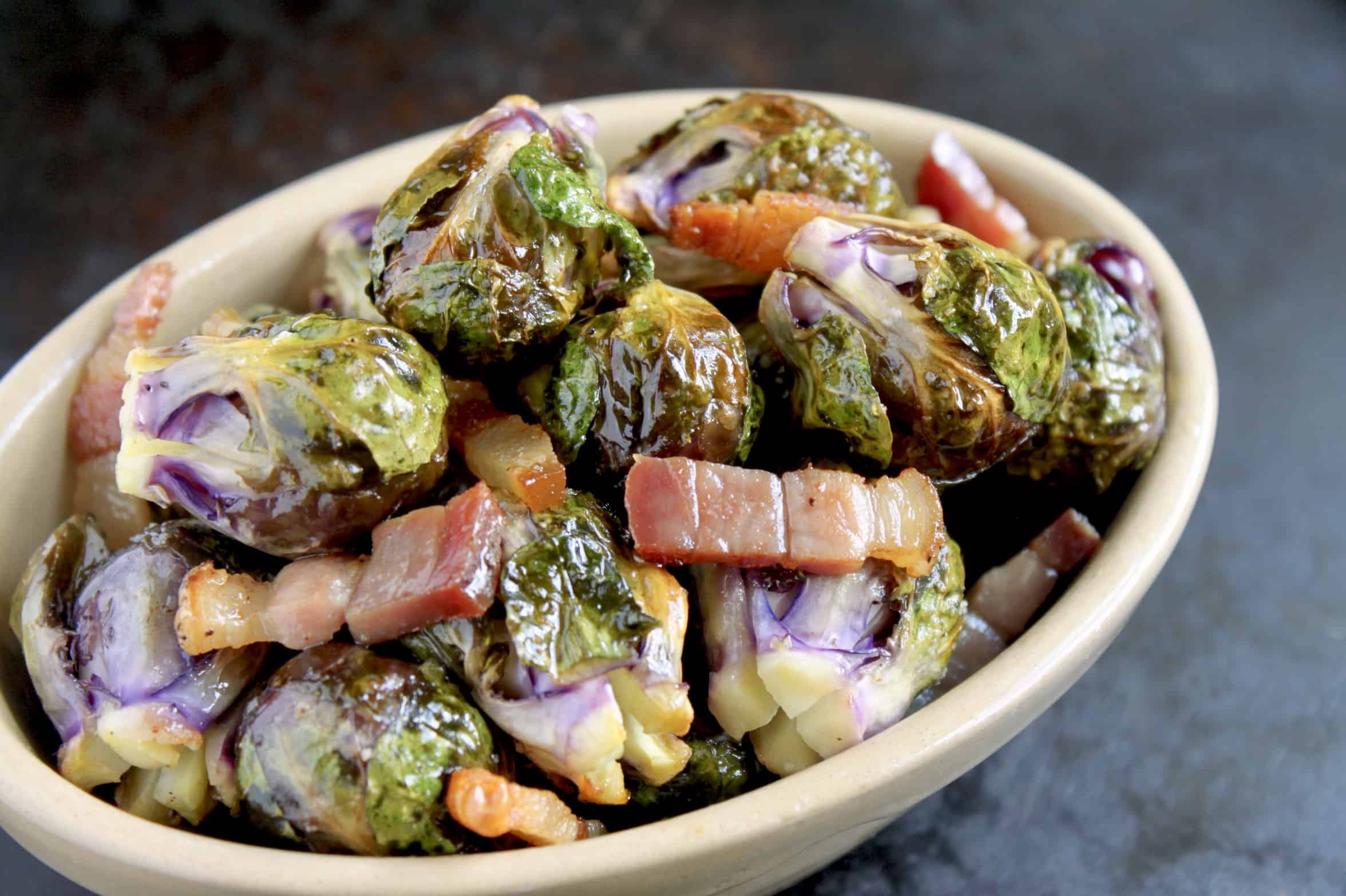
This leads me to say that there is yet another added bonus in making your own pancetta, and that is that it will be NITRATE and NITRITE FREE.* You can always have pancetta on hand and it will last much longer if you have a food sealer.
Pancetta and Porchetta are Two Very Different Things!
Don’t mix up the two as some people do. Pancetta is cured pork belly, whilst porchetta is a roasted pork belly. Just because they are two Italian pork products which start with P, If you have a hard time differentiating or remembering the difference, remember that pancetta = “cooked in a pan“, as it is cooked after curing. Porchetta is roasted, on the other hand. Hope this helps!
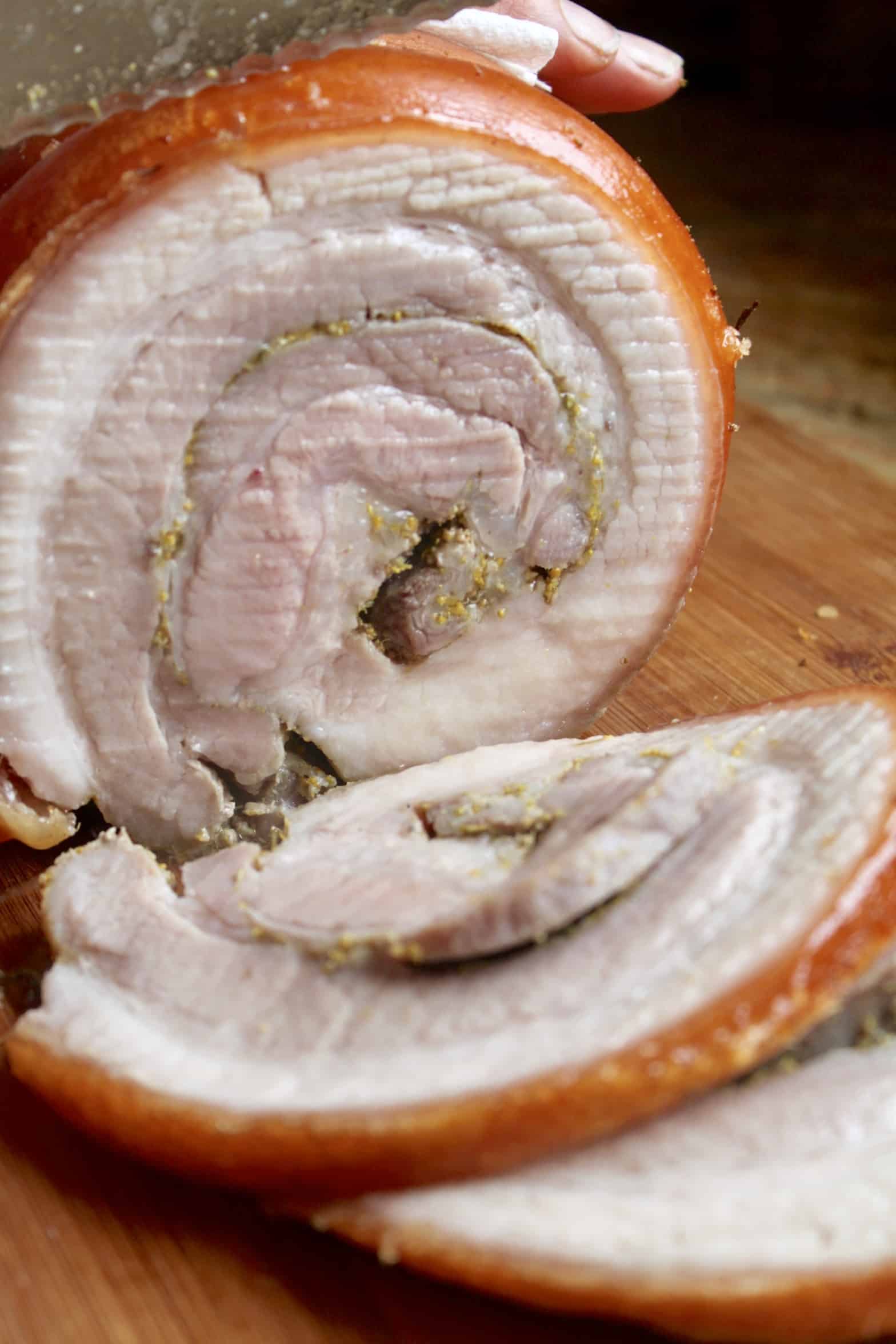
Here’s a recipe using pancetta, to give you an idea of how versatile it is!
Caramelized Onion, Pancetta and Feta Cheese Quiche

Just follow the simple step by step directions below and you too can make homemade pancetta. Yes, even if you live in Los Angeles, or a similarly warm climate.
Here is a recipe for fresh pea soup using your homemade pancetta.
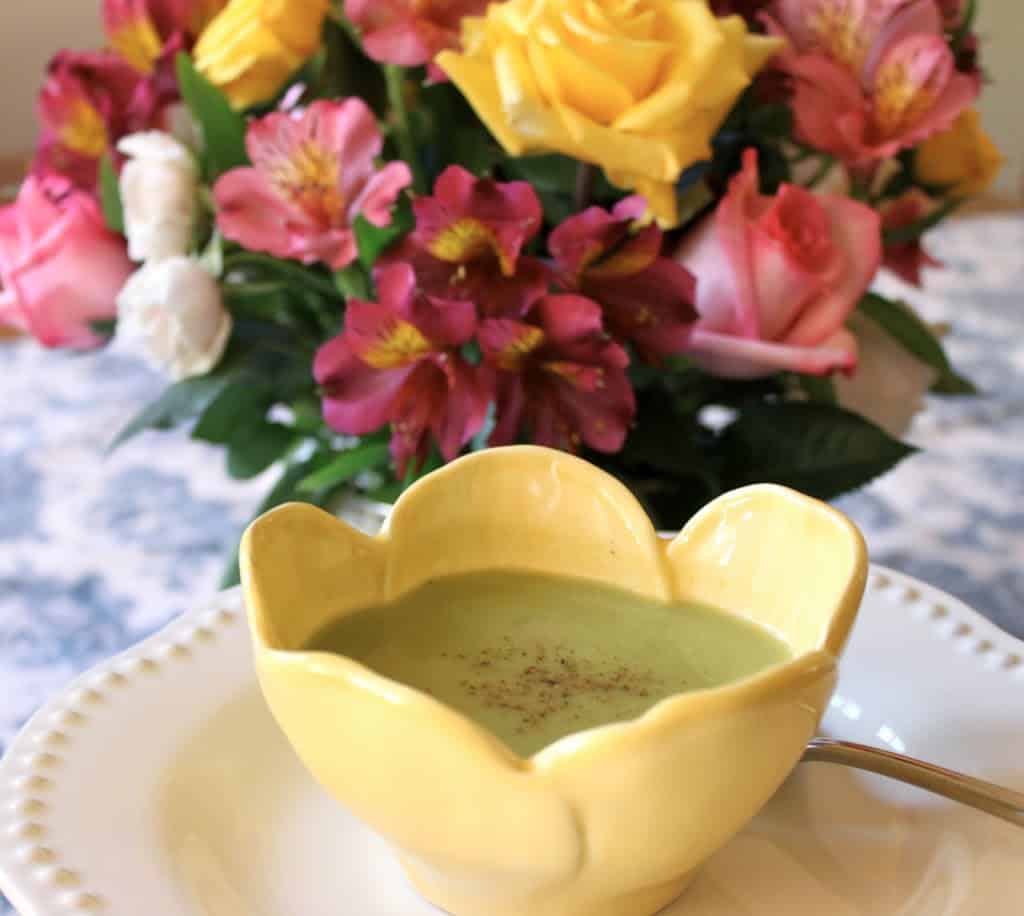
This is a recipe for penne alla vodka which also includes pancetta.
There’s nothing as satisfying as slicing into your own homemade cured pork products!
It’s just a beautiful thing. Pin to your Pinterest boards.
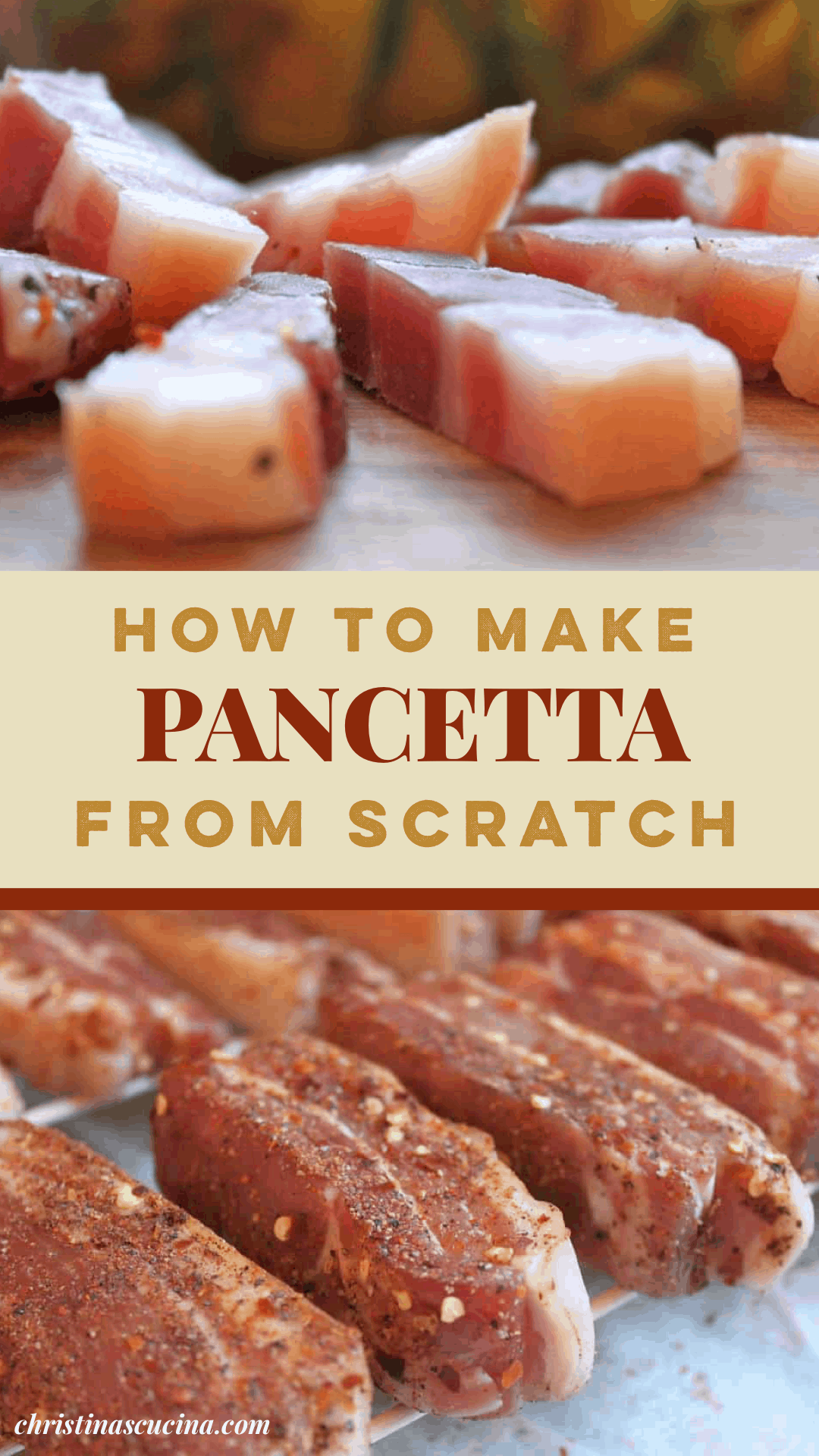
*As with any uncooked, cured meat product, there are risks involved if the product is not made correctly, or if it is not cooked thoroughly. I take no responsibility for any illness incurred from using this recipe.
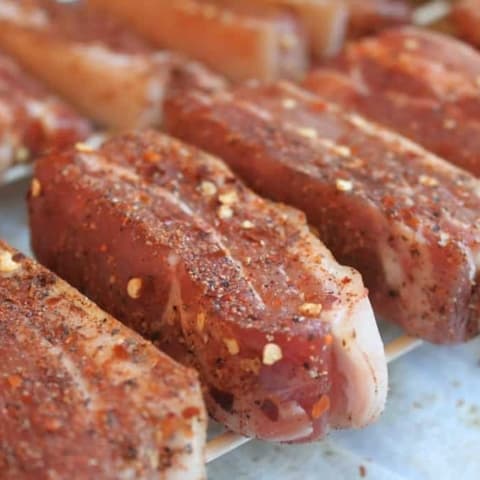
Homemade Pancetta Recipe (How to Make Pancetta)
A simple way to use your refrigerator to make homemade pancetta.
Ingredients
- 2 lbs fresh pork belly slices, with rind (preferably organic), do NOT use pork which has previously been frozen
- about a cup of Kosher salt (please don't worry about measurements on this, just follow the directions)
- about 8 oz of any dry white wine
- black pepper
- crushed red pepper (optional)
- ground cayenne pepper (optional)
Instructions
Day 1
- Salt the pork pieces generously (like a light blanket of snow--see my photo) with Kosher salt and leave for 24 hours in the fridge.
- Do not substitute with other salt, it will not work properly.
Day 2
- The next day, rinse the pork with water, pat dry with a paper towel, and rinse in white wine, but do not pat dry. You will be throwing away the white wine, so try to use as little as you can to still rinse the meat. This helps to preserve the pork.
- Prepare a plate or tray with the desired amount of pepper in any combination. (The amount shown did not make a very spicy pancetta.) Mix all the pepper together.
- Rub the pepper into the pancetta pieces until well coated, adding more pepper as needed. Again, measurements are not critical, just look at my photos for inspiration. Use as much as you like. Set aside on waxed paper.
- You will need a small tray which will fit long skewers to rest upon. This creates something that the pancetta pieces can be placed on to dry so that the air moves around it. You can see what I have done in the photos above. Place the pieces of pancetta spaced apart on top of the wooden skewers and place in a well ventilated fridge (not crowded).
The following 2 or 3 weeks
- The pancetta pieces will be kept in the refrigerator, loosely covered with wax paper, for about 2 to 3 weeks. Turn the pieces everyday (using all 4 sides) until the pancetta has cured without becoming overly dry. If you used 2 lbs of pancetta, it should weight approximately 24 oz when it's cured.
- At this time, my preference is to seal it with a food sealer, which locks out all the air, allowing the pancetta to keep refrigerated a longer period of time.
- Finally, you can use the pancetta however you choose, but do not eat it without properly cooking it first.
Notes
- *As with any uncooked, cured meat product, there are risks involved if the product is not made correctly, or if it is not cooked thoroughly. I take no responsibility for any illness incurred from using this recipe.
Nutrition Information:
Yield: 16 Serving Size: 1Amount Per Serving: Calories: 121Total Fat: 11gSaturated Fat: 4gTrans Fat: 0gUnsaturated Fat: 8gCholesterol: 52mgSodium: 3836mgCarbohydrates: 1gFiber: 0gSugar: 0gProtein: 14g
Nutrition information is only estimated.
Don’t miss another recipe or travel post; sign up for my free subscription below.
Christina’s Cucina is a participant in the Amazon Services LLC Associates Program, an affiliate advertising program designed to provide a means for sites to earn advertising fees. This is done by advertising and linking to Amazon.com.


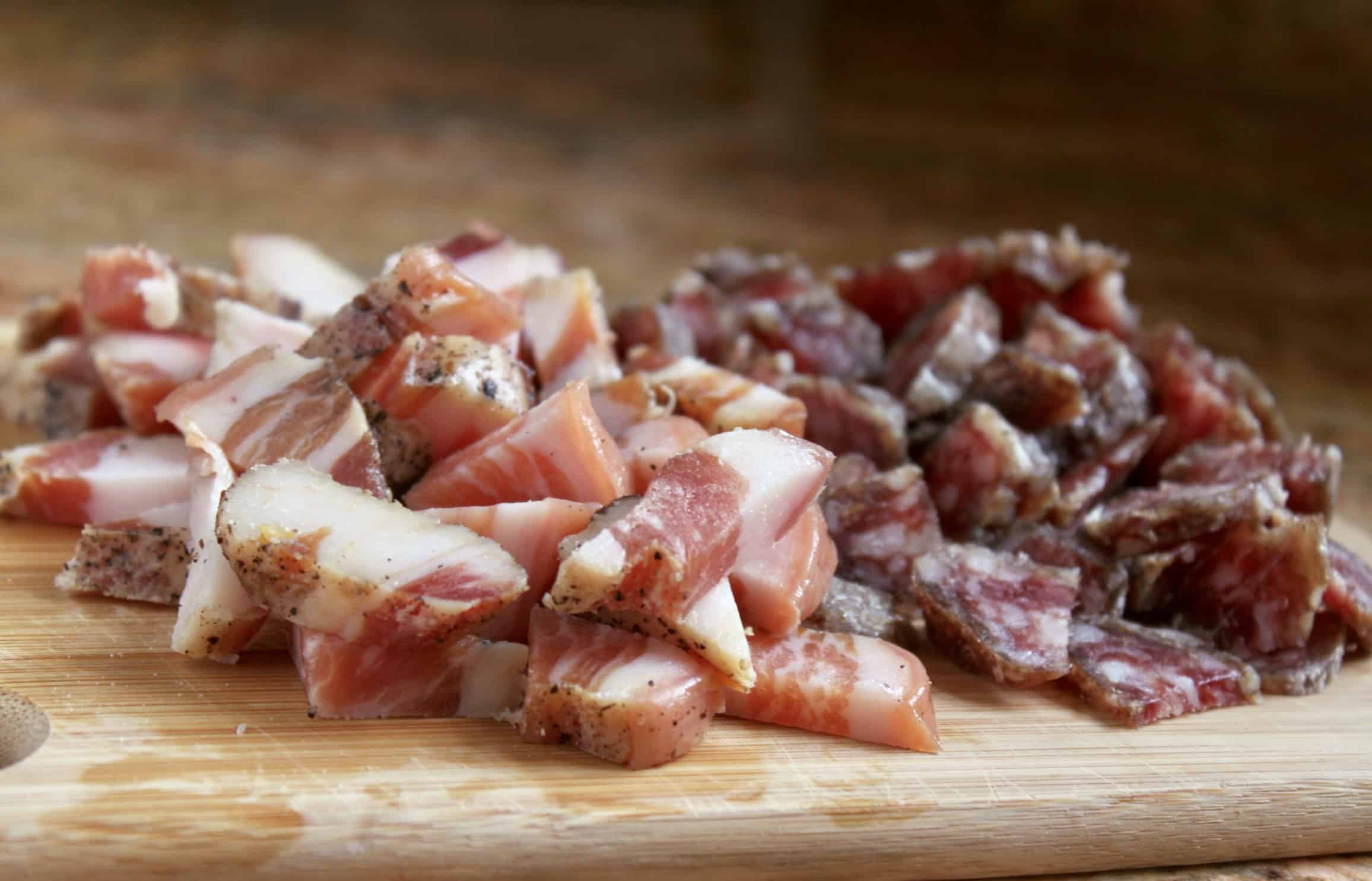





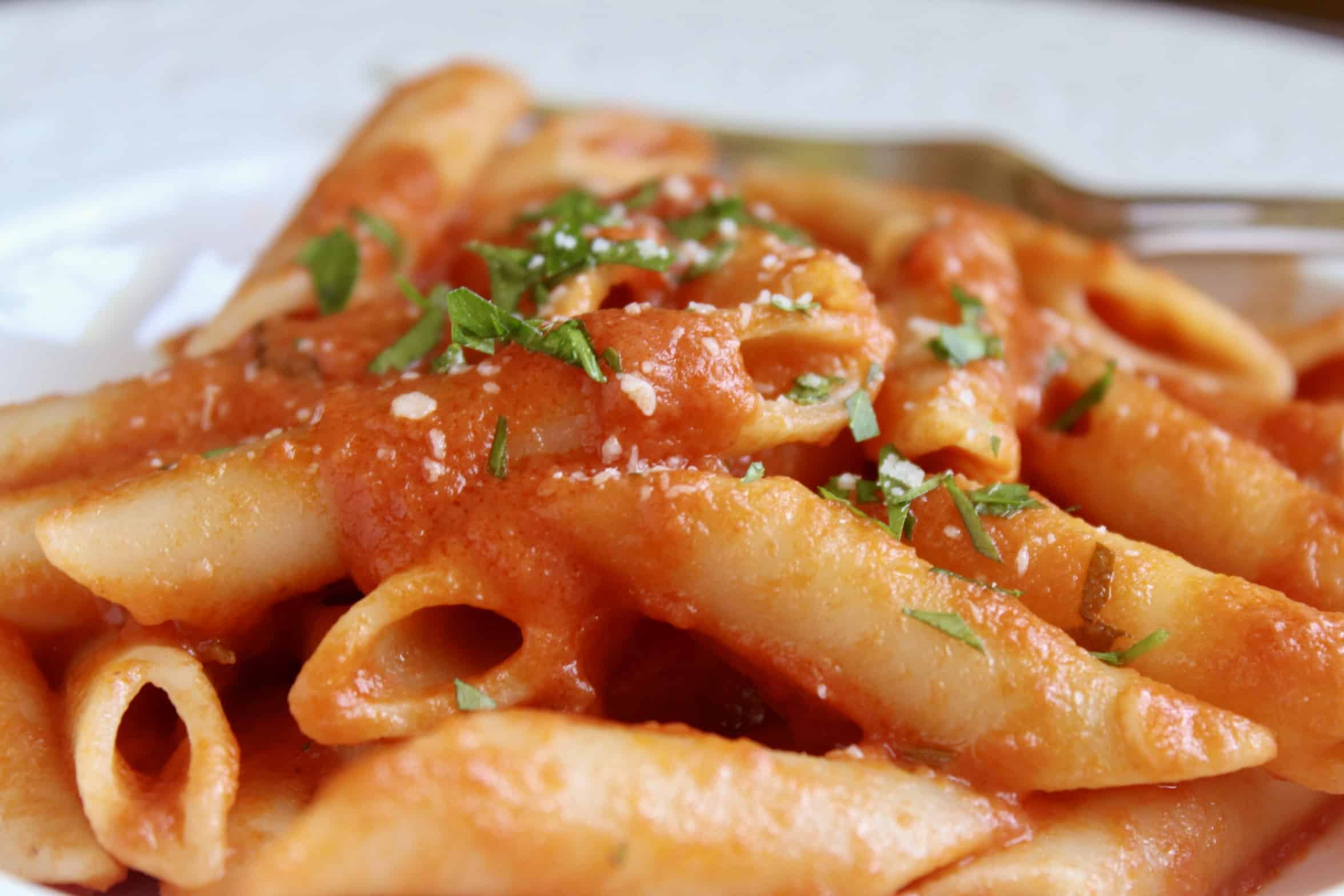

I dont know what part if Italy your nonni were from but where my parents are from, Verona and Treviso Provinces, salt and pepper are NOT the only cure and or flavoring used.
From what i see, all you are making in bacon and NOT pancetta.
Pancetta is dry OR liquid brined, THEN rolled as tight as possible.
Tied tight every inch to inch and a half, THEN hung in a cantina.
I’ve been making it for 45 years, same way, same ingredients of the families recipes brought over in the 20’s by my nonnis.
Any way, every province is different and no one recipe is the “right” recipe.
Hi Andre,
My family is from (and are still living in) Lazio, which is why your recipe is most likely quite different. I never said anywhere in my post that this is the only way pancetta is made. What I’m referring to in my post is people sharing recipes who have no idea what pancetta really is, or who haven’t even been to Italy to taste the real deal, yet are giving recipes on how to make it.
This recipe is not for bacon, but pancetta. Pancetta does not have to be rolled in order to be pancetta. It also does not need to be tied, or made in a cantina to be called pancetta.
CC
Is there a reason why you cannot use frozen pork belly?
I wanted to order from Cheshire pork online since I’ve read that it’s great quality but it comes vacuum sealed and frozen.
Yes, it’s health and safety reasons, Dana. You simply don’t want to chance curing meat that’s been previously frozen. It’s an added step that should not be part of the curing process. Of course, it can be done, but I would personally not take the chance.
Thanks for your recipe Christina. It certainly is an uncomplicated, easy approach and has the ring of something authentic. I just want to add that I have been making pancetta for several years using frozen pork belly. It’s the only way I’ve ever found it to come, even when I purchase a whole pig, which is always frozen by the butcher. I’ve had no problems using previously frozen, although my butcher is very reliable, and the pig that I buy from the farmer is never allowed to thaw at all. Maybe reliability of the meat when frozen is the most important factor?
Absolutely! Given the same with raw eggs, I wouldn’t suggest eating them raw unless they are from backyard chickens, etc. Glad you’re making pancetta, too!
Could you please explain what types of pepper you use /recommend. Is it just regular peppercorns, or do you use chili pepper too? Thank you.
Yes, black pepper (freshly ground if possible), cayenne and crushed red pepper flakes (all listed in the recipe card). Enjoy, Becca!
And so they are (listed)! Thank you for this recipe. I only wish I had experience tasting authentic Pancetta.
It turned out tasty, (even with only black pepper), but I have nothing to compare it with. Maybe someday.
I really do hope you can one day, Becca! Italy is treasure trove of beautiful food and sights!
Hi Christina,
Have read through and was wondering if this could be done with a slab of Pork Belly about 2 kilo then divided up, Vacuum Packed and frozen
Gary
Hi Gary, I wouldn’t advise doing such a big piece in the fridge. Since you plan to divide it up later, just cut it into pieces first, cure it and then seal in bags. I wouldn’t freeze it, either.
I’m a little concerned about the safety of this recipe. I’ve probably missed it in the details, but how do you protect the meat from botulism in this recipe? Especially as you are saying that the cured meat can be stored for 6 months in the fridge, if vacuum sealed.
Hi Michael, I would suggest you use a recipe that adds preservatives if you are concerned about the safety of this recipe. When something is vacuum-sealed it lasts much longer than normal as there is no air in contact with the product; that is not an issue.
You should be concerned. This recipe is going to get someone extremely sick someday. Nobody who knows what they are doing makes pancetta without some kind of curing agent.
Billions of people are on this earth from generations who have cured meats without curing agents, including me. No one in my extensive Italian family has even had a tummy ache from all of our cured meats. THE MOST IMPORTANT ISSUE is the meat itself. Try this with store bought meat that has been frozen with no clue where it came from and I’d agree with you: someone may get sick or worse. This is the part most people (with similar opinions to you) overlook. The process isn’t the issue, the ingredients are.
Hi Christina,
I am going to make this today! Thanks for this recipe! I had a question: I’m wondering if you can share your thoughts about why you recommend kosher salt specifically, and not table salt? Is the iodine in table salt undesirable? What about other additives like anti-caking agents or minerals like in sea salt?
Aside, the only “kosher salt” at my grocery store contains “yellow prussiate of soda”, an anti-caking additive (but no iodine). Is this okay to use?
Hi Archie, it’s not about the iodine, but the size of the salt crystals. Fine grained table salt will oversalt your pancetta, it simply won’t work. If that Kosher salt you are referring to is Morton’s, I don’t recommend it (and neither do chefs). I bought it once and being used to Diamond Crystal Kosher salt, I honestly hated it. Diamond Crystal also has no additives, just salt, so that’s the one to use. Can you see if another store might have it. My Costco has it and the box is $2.49 I believe.
Hi Christina, thank you for the quick reply! That’s very helpful. I am in Canada and the brand of kosher salt I found was Windsor Coarse Kosher Salt, a Canadian brand. Unfortunately I wasn’t able to find Diamond Crystal at my usual grocer, nor at Costco (in fact they didn’t have any brand of kosher salt!). Thanks also for your opinion on Morton’s – I will probably avoid it in the future and keep looking for Diamond Crystal, which I’m sure I’ll find somewhere.
By the way, are there any possibile substitutes for dry white wine in this recipe? It’s not something we usually have on hand. I did see another pancetta recipe online where they called for beer as the rinse. How do you feel about using beer instead? Of course, if the primary purpose of the wine rinse is for it’s antiseptic properties, maybe I could use vodka! :-)
Thanks again!
Very attractive recipe and presentation of what we call in France “petit sale'” [Little salt} which is intensively used in South France.’ cuisine.
Good to know, thank you, Jean-Philippe!
Oh goodness, I missed this comment, Archie, I’m so sorry! Better late than never: yes, I’d opt for vodka over beer, but would honestly choose to go buy an inexpensive bottle of white wine over both. Even if you just use it for the pancetta.